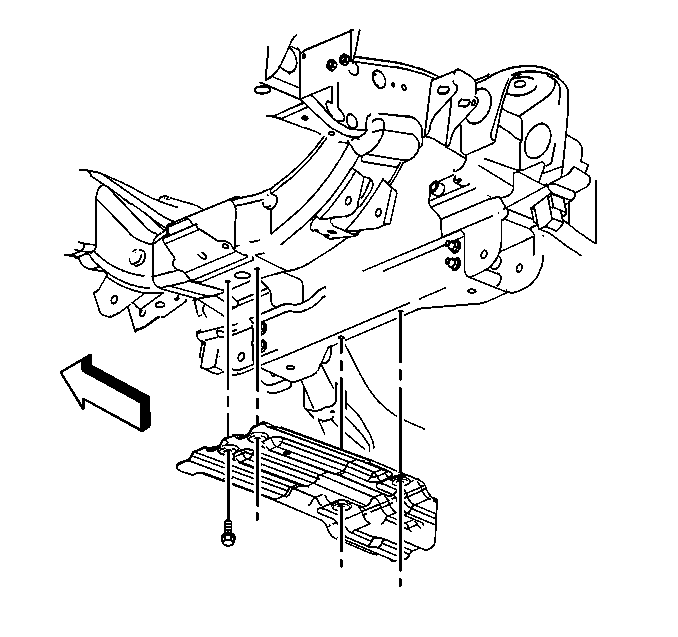
- Disconnect the negative
battery cable. Refer to
Battery Negative Cable Disconnection and Connection
in Engine Electrical.
- Drain the cooling system. Refer to
Cooling System Draining and Filling
in Engine Cooling.
- Raise and suitably support the vehicle. Refer to
Lifting and Jacking the Vehicle
in General Information.
- If equipped, remove the oil pan skid plate bolts and plate.
- Remove the engine shield, if equipped. Refer to
Engine Protection Shield Replacement
in Frame and Underbody.
- Remove the starter. Refer to
Starter Motor Replacement
in Engine Electrical.
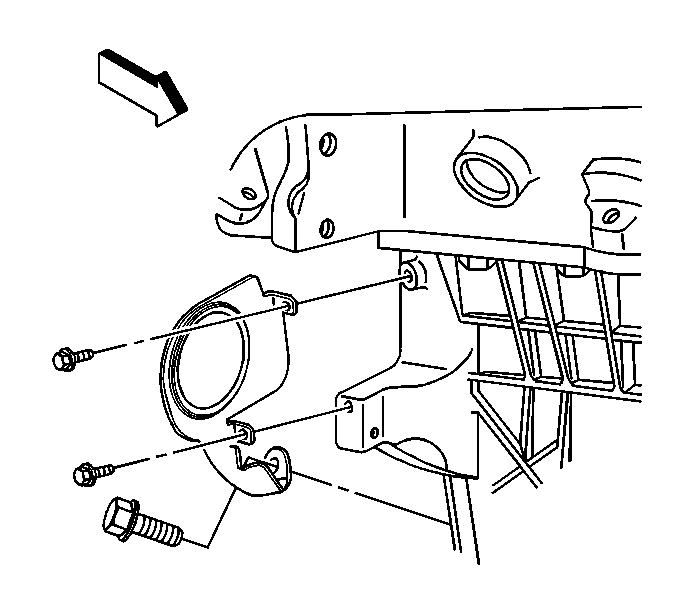
- Remove the transmission
cover.
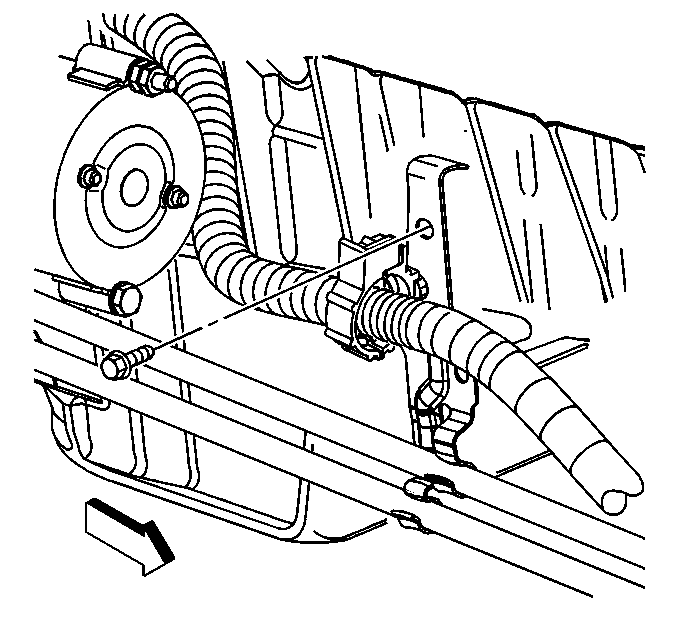
- Remove the transmission
oil cooler line bracket bolt, if equipped.
- Remove the catalytic converter. Refer to
Catalytic Converter Replacement
in Engine Exhaust.
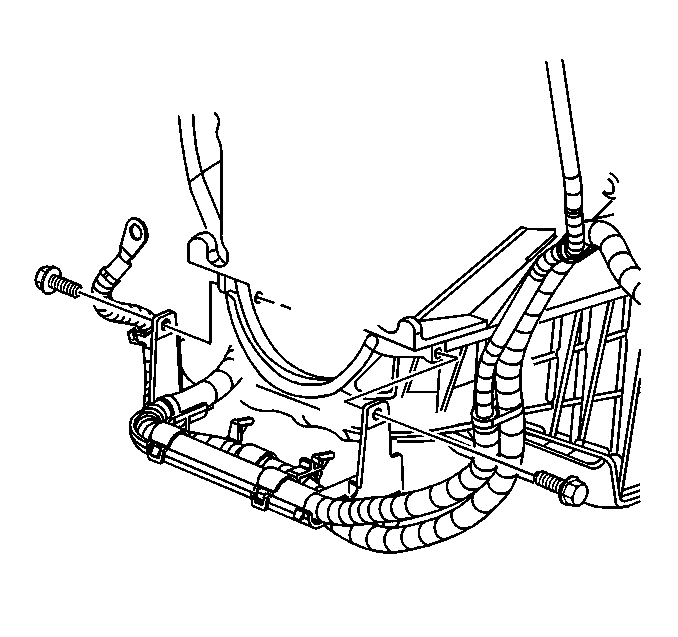
- Remove the battery cable
bracket bolts.
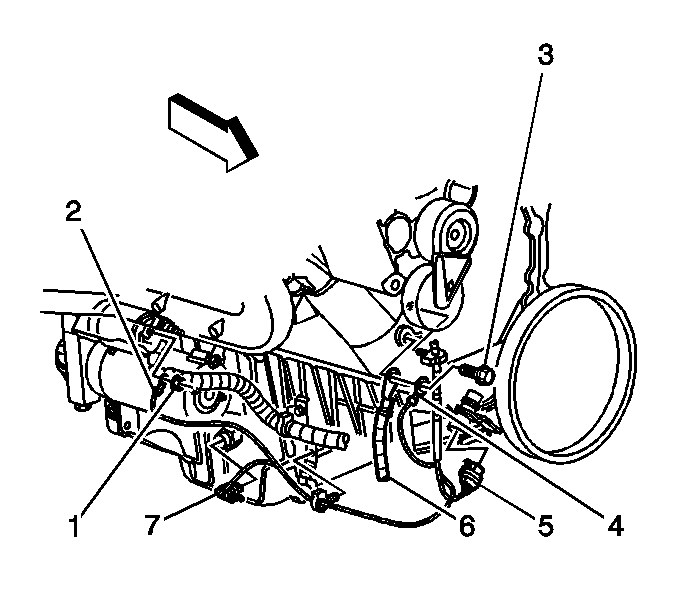
- Disconnect the low oil
level sensor electrical connector (7).
- Disconnect the crankshaft position (CKP) sensor electrical connector
(5) and remove the harness from the retainer clip.
- Remove the ground bolt (3) holding the battery negative cable
and a ground cable to the engine.
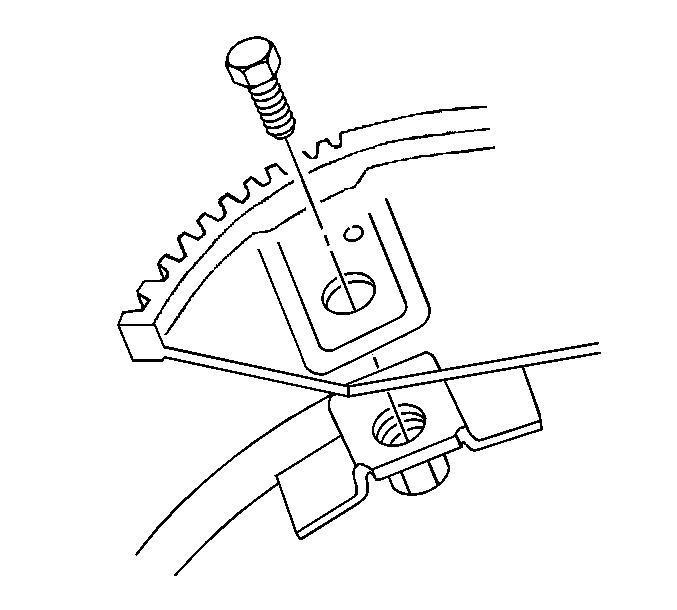
- Remove the torque converter
bolts, if equipped, through the starter opening.
- Remove the transmission bolts.
- Lower the vehicle.
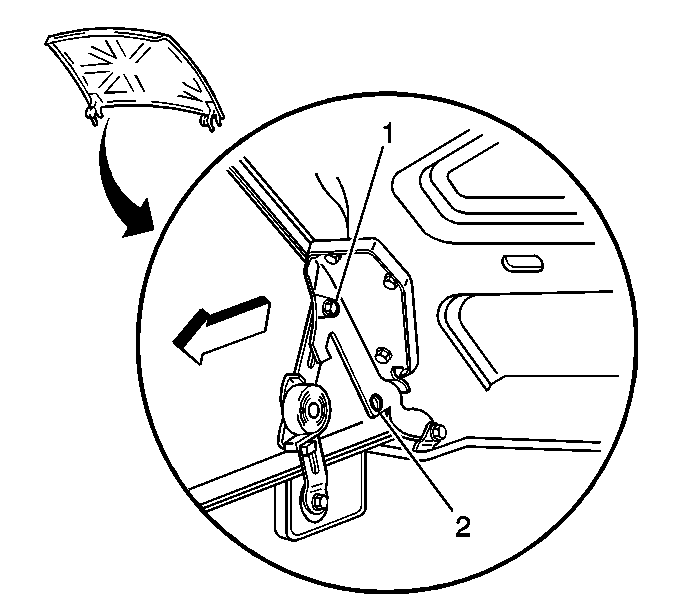
- Raise the hood to the
service position, perform the following:
| 17.1. | Remove the hood hinge bolts (1). |
| 17.2. | Raise the hood until vertical. |
| 17.3. | Install the hood hinge bolts until snug in the service position
(2). |
- Remove the fuel pipes/hoses. Refer to
Fuel Hose/Pipes Replacement - Engine Compartment
in Engine Controls
- 4.3L.
- Remove the lower fan shroud. Refer to
Engine Coolant Fan Lower Shroud Replacement
in Engine Cooling.
- Remove the drive belt. Refer to
Drive Belt Replacement
.
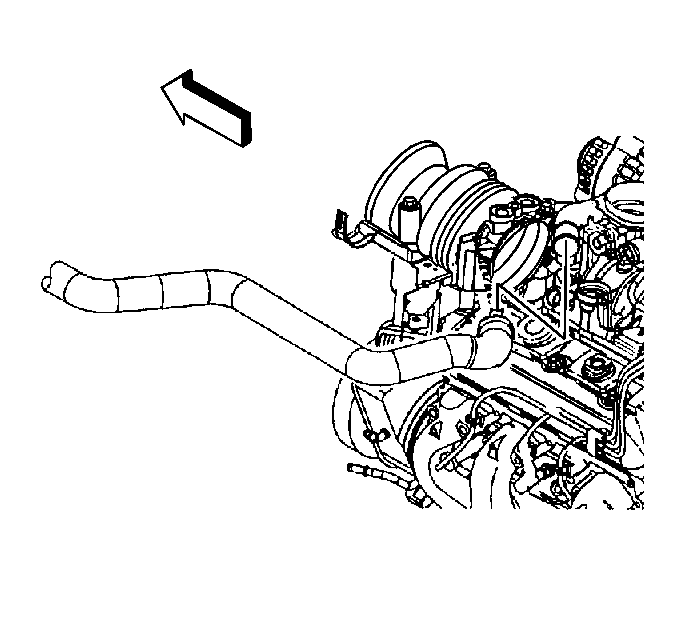
- Reposition the radiator
inlet hose clamp.
- Remove the radiator inlet hose from the thermostat housing.
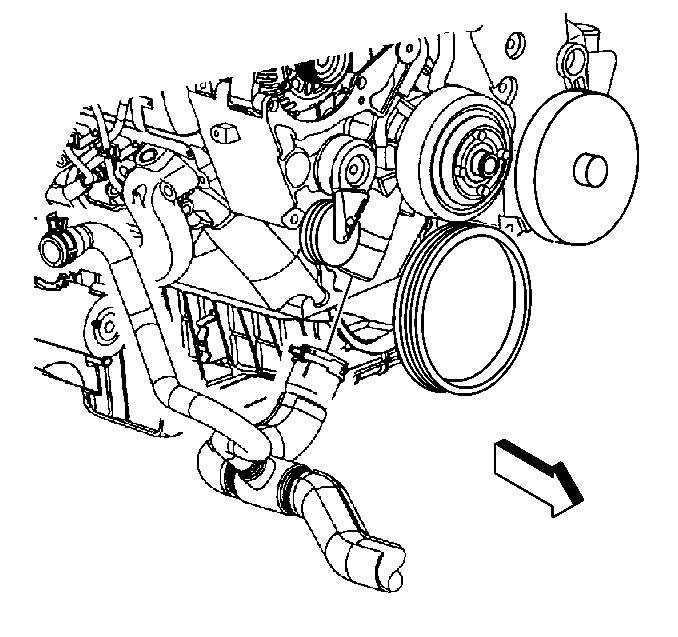
- Reposition the radiator outlet hose clamps.
- Remove the radiator outlet hose from the surge tank.
- Remove the radiator outlet hose from the water pump.
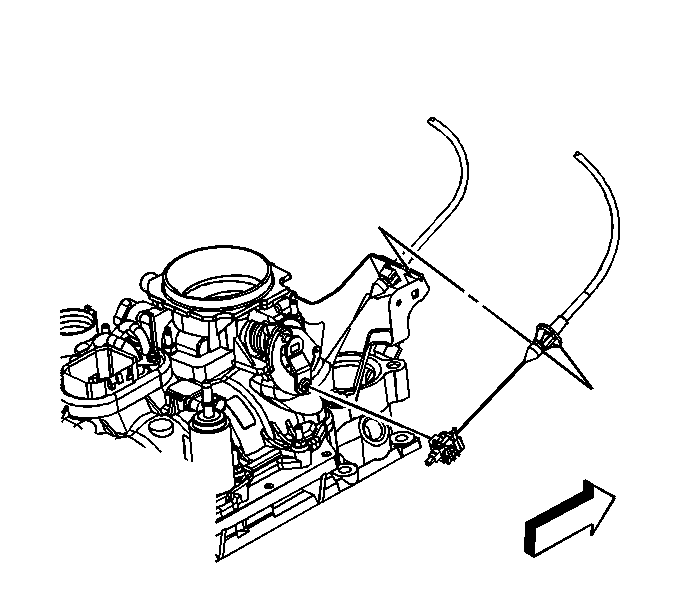
- Disconnect the cruise
control cable from the throttle lever, if equipped.
- Remove the cruise control cable from the accelerator control cable
bracket, if equipped.
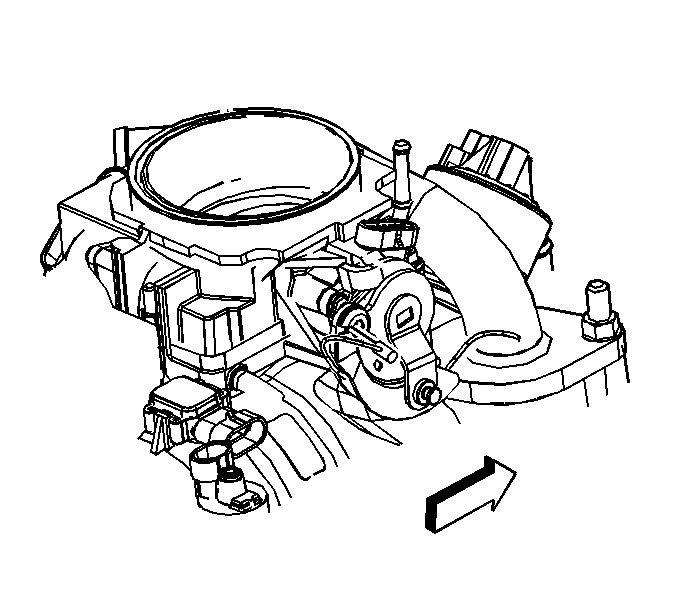
- Remove the accelerator
cable from the throttle body lever.
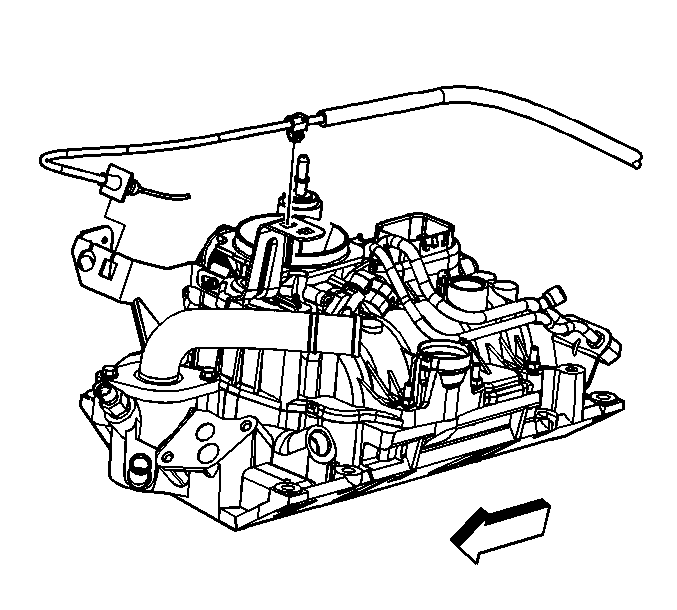
Caution: In order to avoid possible injury or vehicle damage, always replace
the accelerator control cable with a NEW cable whenever you remove the engine
from the vehicle.
In order to avoid cruise control cable damage, position the cable out
of the way while you remove or install the engine. Do not pry
or lean against the cruise control cable and do not kink the cable. You must
replace a damaged cable.
- Remove the accelerator cable from the accelerator control cable bracket.
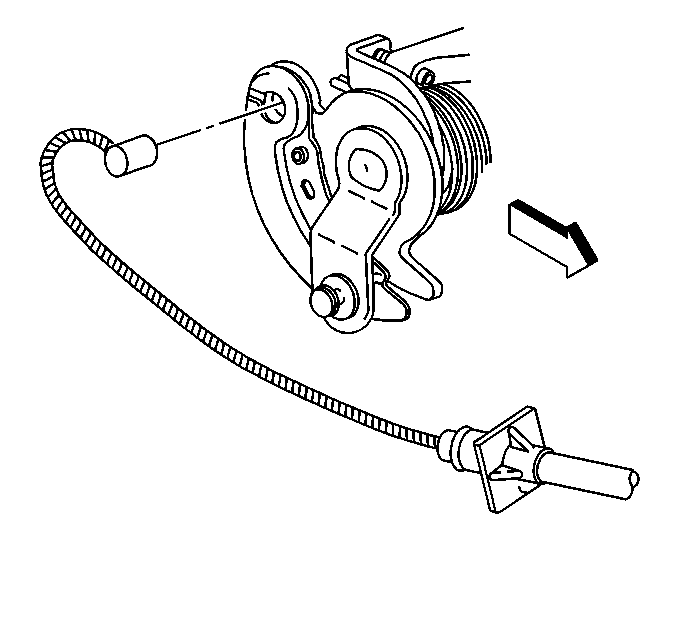
- Remove the accelerator
cable from the throttle body lever.
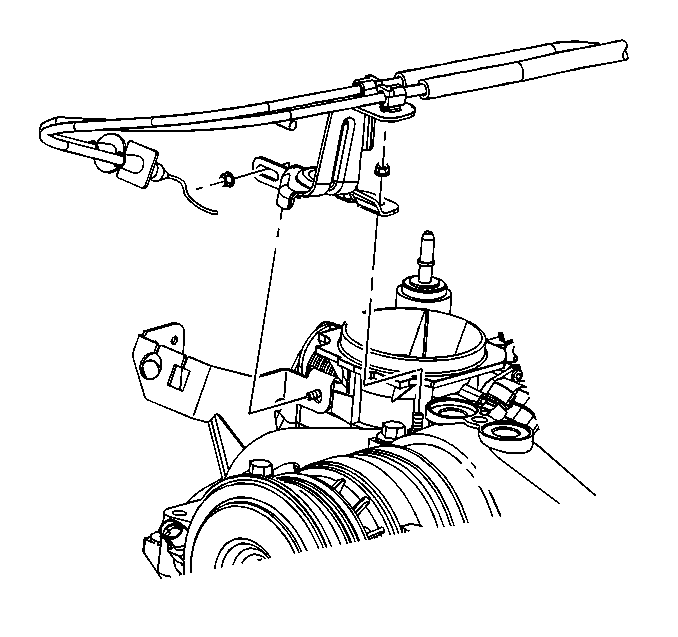
- Remove the accelerator
control cable bracket nuts
- Remove the accelerator control cable bracket with the cables attached,
from the throttle body.
- Reposition and secure the bracket and cables out of the way.
- Remove the air conditioning (A/C) compressor hose, if equipped.
Refer to
Compressor Hose Assembly Replacement
in Heating, Ventilation, and Air Conditioning.

- Disconnect the following
electrical connectors:
| • | The A/C pressure switch (4), if equipped |
| • | The A/C compressor clutch (1), if equipped |
| • | The exhaust gas recirculation (EGR) valve (2) |
- Remove the positive cable nut and cable from the generator.
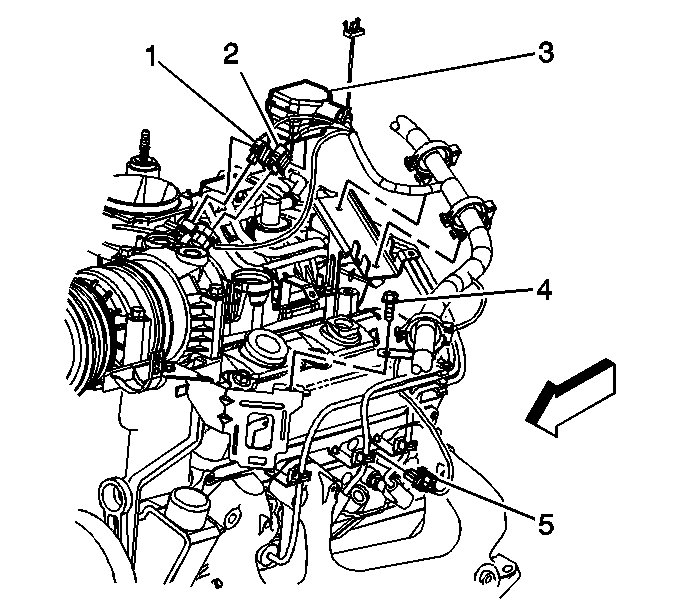
- Disconnect the following
electrical connectors:
| • | The throttle position (TP) sensor (1) |
| • | The idle air control (IAC) motor (2) |
| • | The control port injector module (3) |
| • | The engine coolant temperature (ECT) sensor (5) |
- Remove the engine wiring harness clip bolt (4).
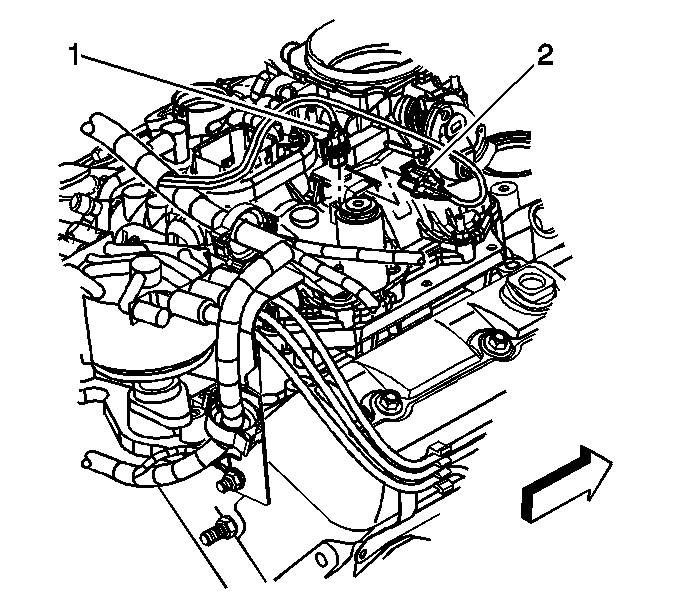
- Disconnect the following
electrical connectors:
| • | The evaporative emission (EVAP) canister purge solenoid valve
(1) |
| • | The manifold absolute pressure (MAP) sensor (2) |

- Disconnect the following
electrical connectors:
| • | The ignition coil driver (2) |
- Remove the engine wiring harness ground nut and ground wire (4)
from the rear of the right cylinder head.

- Disconnect the following
electrical connectors:
| • | The knock sensor (KS) (1) |
| • | The camshaft position (CMP) sensor (2) |
| • | The fuel pump/oil pressure sensor (3) |
- Remove the harness ground bolt.
- Reposition the harness ground (4) and ground strap (5).

- Remove the engine wiring
harness bracket nuts.
- Remove the engine wiring harness bracket from the studs.
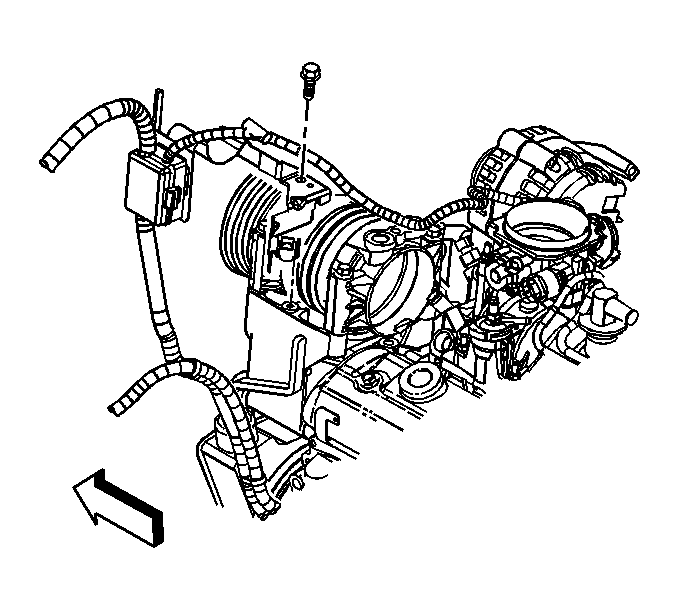
- Remove the junction block
bracket bolt.
- Reposition the bracket and wiring harness aside.

- Remove the engine wiring
harness rear bracket nut at the EVAP canister purge solenoid valve.
- Remove the stud holding the engine wiring harness bracket.
- Reposition the engine wiring harness with the bracket aside.
- Remove the heater hoses. Refer to
Heater Inlet Hose Replacement
and
Heater Outlet Hose Replacement
in Heating, Ventilation, and
Air Conditioning.
- Remove the distributor cap. Refer to
Distributor Replacement
in Engine Controls - 4.3L.
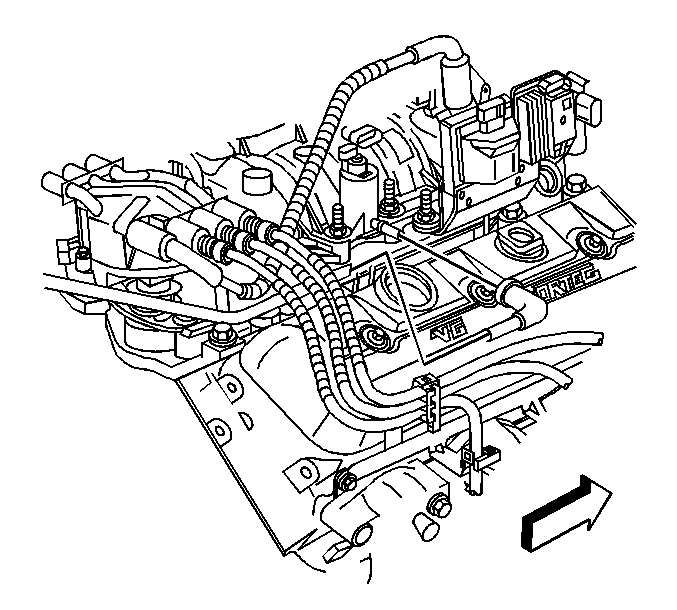
- Disconnect the EVAP canister
harness from the purge solenoid valve.
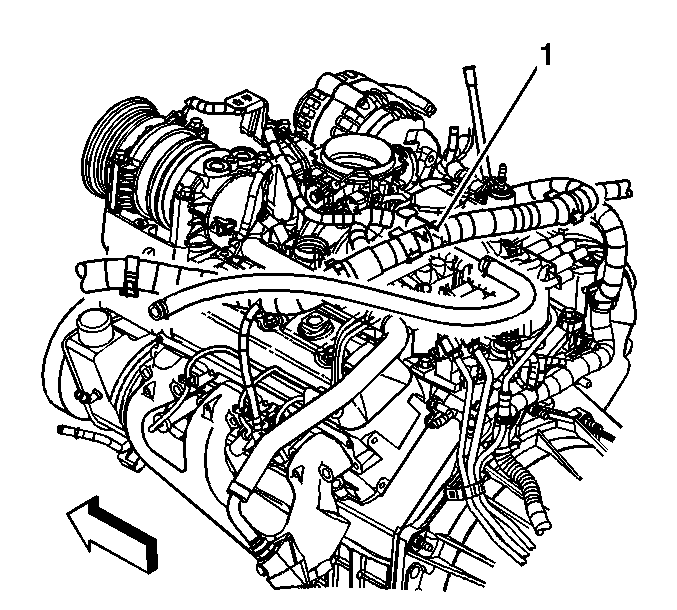
- Disconnect the power brake
booster vacuum hose from the vacuum fitting (1).
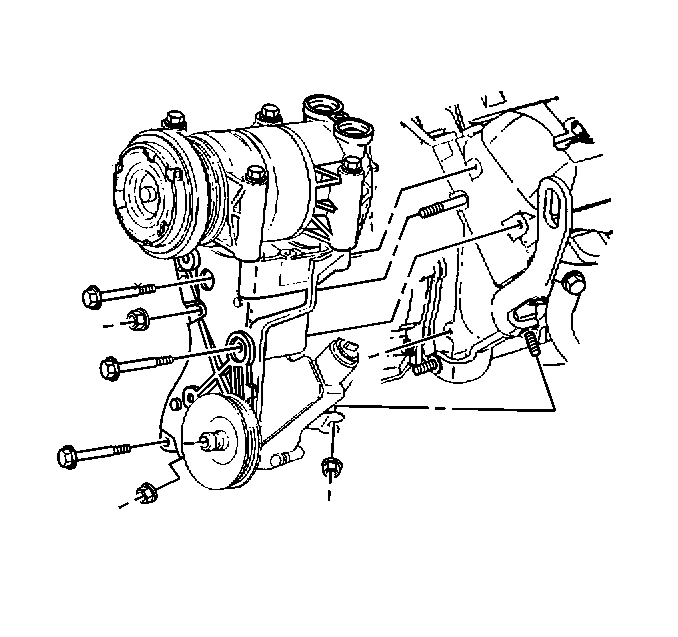
- Loosen the power steering
(P/S) pump rear bracket nut.
- Remove the P/S pump rear bracket front nut.
- Remove the bolts and the nut for the P/S pump bracket.
- Leave the A/C compressor, if equipped and the P/S pump on the
bracket.
- Slide the P/S pump bracket off the stud and set aside.
- Remove the thermostat and water outlet. Refer to
Engine Coolant Thermostat Replacement
in Engine Cooling.
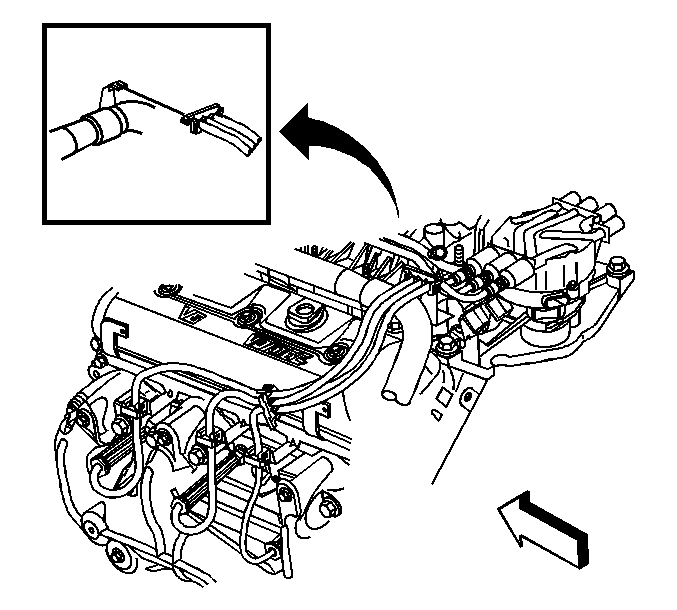
- Remove the spark plug
wire harness retainer from the EGR valve inlet pipe.

- Remove the EGR valve inlet
pipe bracket bolt.
- Remove the EGR valve inlet pipe.
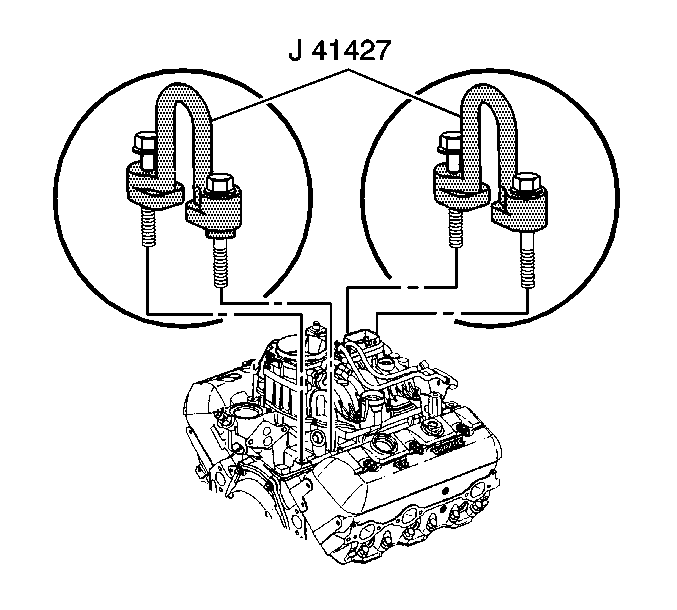
- Remove the left front
and right rear intake manifold - lower bolts.
- Install J 41427
to the left front and right rear intake manifold bolts, using the following
procedure:
| 66.1. | Install the J 41427
marked RIGHT REAR. |
Notice: Use the correct fastener in the correct location. Replacement fasteners
must be the correct part number for that application. Fasteners requiring
replacement or fasteners requiring the use of thread locking compound or sealant
are identified in the service procedure. Do not use paints, lubricants, or
corrosion inhibitors on fasteners or fastener joint surfaces unless specified.
These coatings affect fastener torque and joint clamping force and may damage
the fastener. Use the correct tightening sequence and specifications when
installing fasteners in order to avoid damage to parts and systems.
| 66.2. | Install the lift bracket retaining bolts. |
Tighten
Tighten the lift bracket bolts to 15 N·m (11 lb ft).
| 66.3. | Install the J 41427
marked LEFT FRONT with the arrow pointing to the front of the engine. |
| 66.4. | Install the lift bracket retaining bolts. |
Tighten
Tighten the lift bracket bolts to 15 N·m (11 lb ft).
- Attach a suitable lifting device to the engine lift brackets.
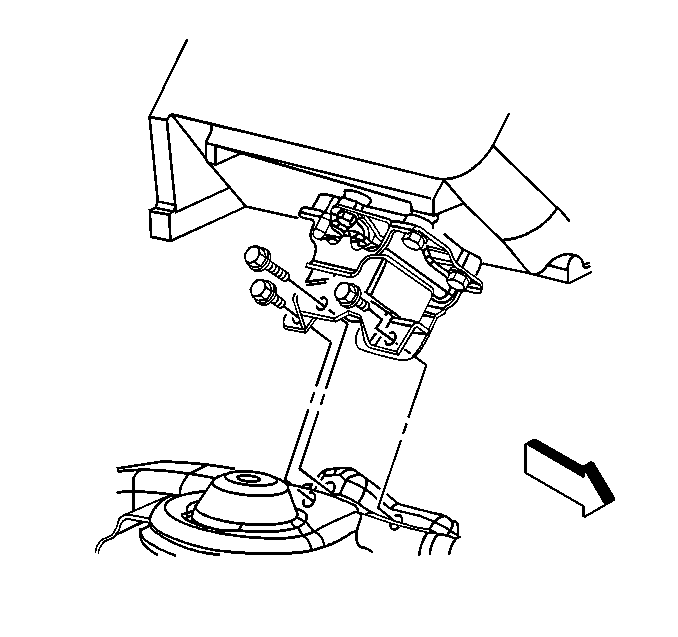
- Remove the engine mount
to engine mount bracket bolts.
- Support the transmission with a suitable floor jack.
- Remove the engine.

- Install the engine.
Notice: Use the correct fastener in the correct location. Replacement fasteners
must be the correct part number for that application. Fasteners requiring
replacement or fasteners requiring the use of thread locking compound or sealant
are identified in the service procedure. Do not use paints, lubricants, or
corrosion inhibitors on fasteners or fastener joint surfaces unless specified.
These coatings affect fastener torque and joint clamping force and may damage
the fastener. Use the correct tightening sequence and specifications when
installing fasteners in order to avoid damage to parts and systems.
- Install the engine mount to engine mount bracket bolts.
Tighten
Tighten the engine mount to engine mount bracket bolts to 65 N·m
(48 lb ft).

- Remove the J 41427
and the lifting device.
- Apply threadlock GM U.S. P/N 12345382, Canada P/N 10953489,
or equivalent to the threads of the intake manifold - lower bolts.
- Install the intake manifold bolts.
Tighten
- Tighten the intake manifold - lower bolts a first pass to 3 N·m
(27 lb in).
- Tighten the intake manifold - lower bolts a second pass to 12 N·m
(106 lb in).
- Tighten the intake manifold - lower bolts a final pass to 15 N·m
(11 lb ft).
- Install one transmission bolt until snug.
- Remove the support jack from under the transmission.

- Install the EGR valve
inlet pipe.
- Install the EGR valve inlet pipe bracket bolt.
Tighten
| • | Tighten the EGR valve inlet pipe fitting to the exhaust manifold
to 25 N·m (18 lb ft). |
| • | Tighten the EGR valve inlet pipe fitting to the intake manifold
to 30 N·m (22 lb ft). |
| • | Tighten the EGR valve inlet pipe bracket bolt to 25 N·m
(18 lb ft). |

- Install the spark plug
wire harness retainer to the EGR valve inlet pipe.
- Install the thermostat and water outlet. Refer to
Engine Coolant Thermostat Replacement
in Engine Cooling.

- Slide the P/S pump bracket
onto the stud.
- Install the bolts and the nut for the P/S pump bracket.
- Install the P/S pump rear bracket front nut.
- Tighten the P/S pump rear bracket nut.
Tighten
Tighten the P/S pump bracket bolts and nuts to 41 N·m (30 lb ft).

- Connect the power brake
booster vacuum hose to the vacuum fitting (1).

- Connect the EVAP canister
harness to the purge solenoid valve.
- Install the distributor cap. Refer to
Distributor Replacement
in Engine Controls - 4.3L.
- Install the heater hoses. Refer to
Heater Inlet Hose Replacement
and
Heater Outlet Hose Replacement
in Heating, Ventilation, and
Air Conditioning.

- Position the engine wiring
harness.
- Install the stud holding the engine wiring harness bracket.
- Install the engine wiring harness rear bracket nut at the EVAP
canister purge solenoid valve.
Tighten
Tighten the engine wiring harness rear bracket nut to 9 N·m
(80 lb in).

- Position the bracket and
wiring harness.
- Install the junction block bracket bolt.
Tighten
Tighten the junction block bracket bolt to 25 N·m (18 lb ft).

- Install the engine wiring
harness bracket to the studs.
- Install the engine wiring harness bracket nuts.
Tighten
Tighten the engine wiring harness bracket nuts to 12 N·m
(106 lb in).

- Position the harness ground
(4) and ground strap (5).
- Install the harness ground bolt.
Tighten
Tighten the harness ground bolt to 16 N·m (12 lb ft).
- Connect the following electrical connectors:
| • | The fuel pump/oil pressure sensor (3) |

- Install the engine wiring
harness ground nut and ground wire (4) to the rear of the right cylinder head.
Tighten
Tighten the engine wiring harness ground nut to 16 N·m
(12 lb ft).
- Connect the following electrical connectors:
| • | The ignition coil driver (2) |

- Connect the following
electrical connectors:
| • | The EVAP canister purge solenoid valve (1) |

- Install the engine wiring
harness clip bolt (4).
Tighten
Tighten the engine wiring harness clip bolt to 9 N·m (80 lb in).
- Connect the following electrical connectors:
| • | The control port injector module (3) |

- Install the positive cable
and nut to the generator.
Tighten
Tighten the positive cable generator nut to 18 N·m (13 lb ft).
- Connect the following electrical connectors:
| • | The A/C pressure switch (4), if equipped |
| • | The A/C compressor clutch (1), if equipped |
- Install the A/C compressor hose, if equipped. Refer to
Compressor Hose Assembly Replacement
in Heating,
Ventilation, and Air Conditioning.

- Position the bracket and
cables.
- Install the accelerator control cable bracket with the cables
attached, to the throttle body.
- Install the accelerator control cable bracket nuts.
Tighten
Tighten the accelerator control cable bracket nuts to 9 N·m
(80 lb in).

- Install the accelerator
cable to the throttle body lever.

Caution: In order to avoid possible injury or vehicle damage, always replace
the accelerator control cable with a NEW cable whenever you remove the engine
from the vehicle.
In order to avoid cruise control cable damage, position the cable out
of the way while you remove or install the engine. Do not pry
or lean against the cruise control cable and do not kink the cable. You must
replace a damaged cable.
- Install the accelerator cable to the accelerator control cable bracket.

- Install the accelerator
cable to the throttle body lever.

- Install the cruise control
cable to the accelerator control cable bracket, if equipped.
- Connect the cruise control cable to the throttle lever, if equipped.

- Install the radiator outlet hose to the water pump.
- Install the radiator outlet hose to the surge tank.
- Position the radiator outlet hose clamps.

- Install the radiator inlet
hose to the thermostat housing.
- Position the radiator inlet hose clamp.
- Install the drive belt. Refer to
Drive Belt Replacement
.
- Install the lower fan shroud. Refer to
Engine Coolant Fan Lower Shroud Replacement
in Engine Cooling.
- Install the fuel pipes/hoses. Refer to
Fuel Hose/Pipes Replacement - Engine Compartment
in Engine Controls
- 4.3L.

- Remove the hood hinge
bolts from the service position (2).
- Lower the hood to the normal position.
- Install the hood hinge bolts.
Tighten
Tighten the hood hinge bolts to 25 N·m (18 lb ft).
- Raise the vehicle.

- Install the transmission
bolts.
Tighten
Tighten the transmission bolts to 50 N·m (37 lb ft).
- Install the torque converter bolts, if equipped, through the starter
opening.
Tighten
Tighten the torque converter bolts to 63 N·m (47 lb ft).

- Install the transmission
cover.
- Install the starter. Refer to
Starter Motor Replacement
in Engine Electrical.
- Install the engine shield, if equipped. Refer to
Engine Protection Shield Replacement
in Frame and Underbody.

- If equipped, install the
oil pan skid plate and bolts.
- Lower the vehicle.
- Connect the negative battery cable. Refer to
Battery Negative Cable Disconnection and Connection
in Engine
Electrical.
- Fill the engine with the proper quantity and grade of oil. Refer
to
Approximate Fluid Capacities
in
Maintenance and Lubrication.
- Add engine oil supplement GM U.S. P/N 1052367,
Canada P/N 992869, or equivalent to the engine oil.
- Fill the cooling system. Refer to
Cooling System Draining and Filling
in Engine Cooling.
- Bleed the hydraulic clutch, if equipped. Refer to
Hydraulic Clutch Bleeding
in Clutch.
- Recharge the A/C system. Refer to
Refrigerant Recovery and Recharging
in Heating, Ventilation, and
Air Conditioning.
Important: After an overhaul, the engine should be tested. Use the following procedure
after the engine is installed in the vehicle.
- Disable the ignition system.
- Crank the engine several times. Listen for any unusual noises
or evidence that parts are binding.
- Start the engine and listen for unusual noises.
- Check the oil pressure gauge or light and confirm that the engine
has acceptable oil pressure.
- If necessary, install an oil pressure gauge and measure the oil
pressure.
- Run the engine speed at about 1000 RPM until the engine has reached
normal operating temperature.
- Listen for sticking valve lifters, or other unusual noises.
- Inspect for fuel, oil, and/or coolant leaks while the engine is
running.
- Verify that the distributor is properly positioned.
- Perform a final inspection for the proper oil and coolant levels.
- Close the hood.























































